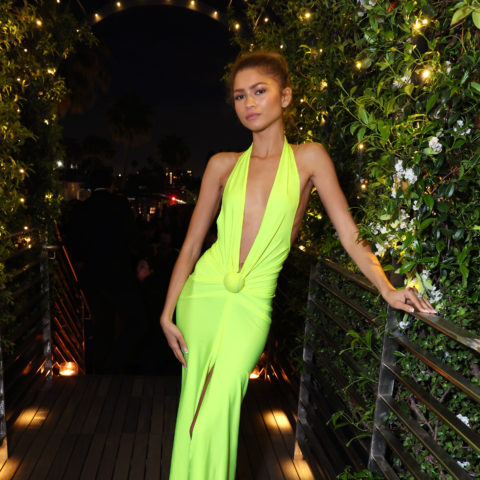Why Saint Laurent is more important and culturally relevant than Yeezy

Ok, sure, Kanye’s 1,000-bodied, Madison Square Garden-staged Yeezy season 3 presentation may have broken the internet (you guys, Kim was there, but isn’t she everywhere?). But it was definitely not the most important event this fashion month so far.
If you weren’t invited to Saint Laurent’s Wednesday night spectacle at the Hollywood Palladium (or desperately trying to be), you were one of the very many patiently waiting for almost an hour for the livestream to start. In Los Angeles, where fly-postered ads for the show covered much of the city, there was an even heavier buzz. And the reasons behind that way outnumber the capacity of Madison Square Garden, or, for that matter, the names on that Yeezy sneaker waiting list.
For Hedi Slimane, the house’s current (but maybe not for long, if those rumours are true) creative director, staging a show in Los Angeles is very much a homecoming in addition to being the 50th anniversary of Rive Gauche, Yves Saint Laurent’s homage to the ‘60s youthquake and also the first ready-to-wear collection, like, ever.
Slimane’s been a long-time Los Angeles advocate since moving stateside not long after his stint at Dior Homme ended, and the city’s been a significant source of inspiration. So much so that Slimane moved all of Saint Laurent’s creative from Paris to L.A. when he started, to be closer to the music scene, the artists and cool young weirdos who inspire him.
No matter where you stand on Saint Laurent (and since Hedi Slimane came on in 2012, critics have been divided even though sales have been through the roof), you can’t deny that this week’s spectacle was more than just a blip. It cemented a moment when both Slimane’s codes and the ideals of the historic house came together in perfect, unisexual and totally rock ‘n roll-wearable harmony.
Hope you’re ready for a really fun and informative history lesson, btw.
First off, let’s explore the significance of Rive Gauche. In 1966, Yves Saint Laurent introduced the secondary ready-to-wear line to his couture house in an effort to democratize fashion. Back then, there was just extreme luxury (couture, stuffy formal French houses) and the people who knocked them off (much more mass-market department stores in America). Yves was beyond progressive, even controversial at the time: tapping into youth culture, he took the idea of the clothes and the ways they were put together by his beatnik friends and put them onto the runway. This… did not go over well with fashion people, who didn’t think stuff kids wore on the street or to the clubs deserved a place in a luxury French fashion house. Like, was he actually charging money for this stuff?
Cut to Slimane’s first collection. The pussy-bowed, skinny-pants’d, ‘70s-inflected debut outraged critics because it felt too real, unimaginative and perhaps a bit regressive. His fabrics, all of which were made specifically for the house, didn’t come off as luxe enough (back when I worked on the editorial side of fashion, I shot a dress from his second collection that felt like it came from Forever 21, in the best and most ironic way). Like, was he actually charging money for this stuff?
It’s pretty obvious that Slimane’s been riffing on Yves’ original concept low key for years. Like Yves, he surrounds himself with artists (L.A.-based John Baldessari, for example, who created the stunning set for the designer’s Fall ‘14 show, along with three glittery, limited-edition dresses for the collection), on-the-rise musicians (Cherry Glazer’s Clementine Creevy, who performed at the Palladium’s after party), established guitar goddesses (Courtney Love, the muse behind Spring ‘16), and cool kids who are perhaps a mix of all of the above (model-musician Staz Lindes, a Saint Laurent runway regular). Like Yves, he’s tapping into the really gritty authenticity that can only come from youth, or at least by fully immersing yourself in it. And that’s way more real, and frankly more appealing, than the presence of any Kardashian.
Along the way, Slimane honed in and developed some codes of his own. There’s the permanent collection, which is comprised of super skinny suiting (for men and women, evocative of his emaciated silhouettes at Dior Homme), fringed leather jackets, pussy bow blouses, Western boots and so many sneakers. There are seasonal campaigns with legends, most notably Joni Mitchell and Courtney Love. There’s the cult casting for unisex capsule collections, which use a mix of little-known actors, musicians and kids Slimane scouts on the street. The teaser video for the Palladium collection features sisters Jessica and Jennifer Clavin from the L.A.-based band Bleached in sparkly minis and tube socks at the Moonlight Rollerway. You don’t get more youthquakey than that.
What Wednesday’s show married was a mix of all of the above—the sharp tailoring, the super-skinny proportions, the metallic boots, the animal prints, the interchangeable men’s and women’s pieces—with some historic revivals. He dug into the archives and revived some key prints, most notably the musical note pattern that first appeared at YSL in 1982. There were caftans that recalled Yves’ widely-known obsession with Marrakech. And, of course, there were plenty of rock ‘n’ roll vibes, from the dudes channelling Gram Parsons to the girls who recalled Joni Mitchell. Also: so many slick leather culottes, which seemed to nod to Yves’ obsession with pants (he made it ok for ladies to wear them thanks to his Le Smoking tux). I am very, very interested in those pants.
Plus, if you hadn’t heard, notoriously press-shy Slimane actually walked out after the show. He’s never done this. Whether that’s the hint of a goodbye or a further evolution of the house, it should be enough of a reason for a fashion obsessive to care, despite that incredibly thorough history lesson.







